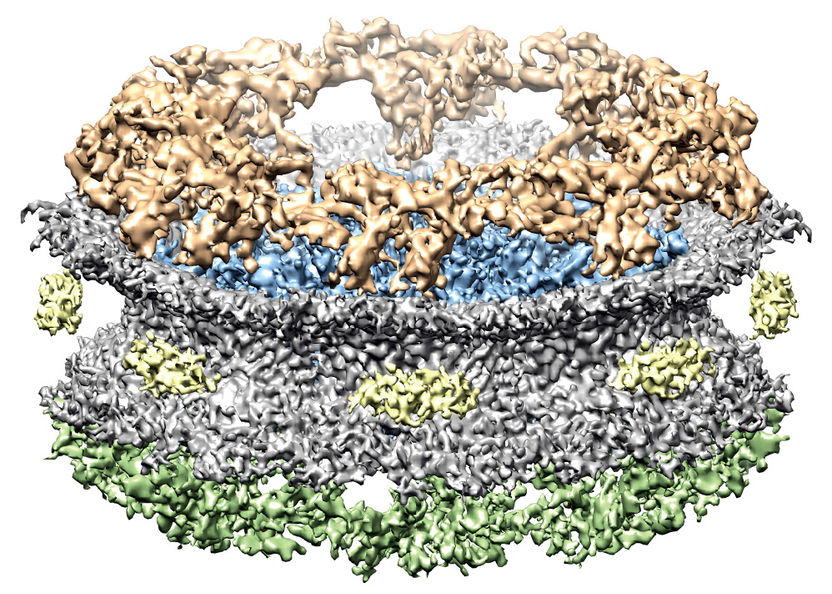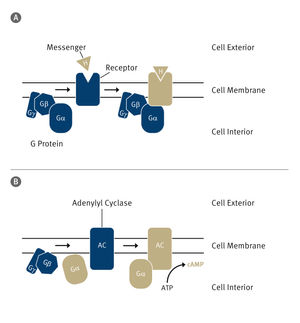High-performance microscope displays pores in the cell nucleus with greater precision
The transportation of certain molecules into and out of the cell nucleus takes place via nuclear pores. For some time, detailed research has been conducted into how these pores embedded in the nuclear envelope are structured. Now, for the first time, biochemists from the University of Zurich have succeeded in elucidating the structure of the transportation channel inside the nuclear pores in high resolution using high-performance electron microscopes.

A bird’s-eye view: The nuclear pore complex is comprised of several layered rings: the cytoplasmic ring (gold), the spoke ring within the pore (blue) and the nucleoplasmic ring (green). The nuclear pore is surrounded by the nuclear envelope (gray).
UZH
An active exchange takes place between the cell nucleus and the cytoplasm: Molecules are transported into the nucleus or from the nucleus into the cytoplasm. In a human cell, more than a million molecules are transported into the cell nucleus every minute. In the process, special pores embedded in the nucleus membrane act as transport gates. These nuclear pores are among the largest and most complex structures in the cell and comprise more than 200 individual proteins, which are arranged in a ring-like architecture. They contain a transportation channel, through which small molecules can pass unobstructed, while large molecules have to meet certain criteria to be transported. Now, for the first time, an UZH research team headed by Professor Ohad Medalia has succeeded in displaying the spatial structure of the transport channel in the nuclear pores in high resolution.
“Molecular gate” discovered in the pore channel
For their study, the scientists used shock-frozen specimens of clawed frog oocytes. With the aid of cryo-electron microscopes, Medalia’s team was able to display the miniscule nuclear pores, which were merely a ten thousandth of a millimeter in diameter, at a considerably higher resolution than ever before. As a result, they uncovered new details: “We discovered a previously unobserved structure inside the nuclear pore that forms a kind of molecular gate, which can only be opened by molecules that hold the right key,” explains Medalia. This “molecular gate” is the so-called spoke ring, which is sandwiched between two other rings and extends inside the nuclear pores. The gate itself consists of a fine lattice, which enables small molecules to slip through unobstructed.
The new, high-resolution presentation of the nuclear pore structure leads to a better understanding of why certain molecules are allowed to pass through the nuclear pores while others are turned away. It also helps improve our understanding of the development of some diseases that involve a defective transportation to the nuclear pores – such as intestinal, ovarian and thyroid cancer.
Original publication
Other news from the department science

Get the life science industry in your inbox
By submitting this form you agree that LUMITOS AG will send you the newsletter(s) selected above by email. Your data will not be passed on to third parties. Your data will be stored and processed in accordance with our data protection regulations. LUMITOS may contact you by email for the purpose of advertising or market and opinion surveys. You can revoke your consent at any time without giving reasons to LUMITOS AG, Ernst-Augustin-Str. 2, 12489 Berlin, Germany or by e-mail at revoke@lumitos.com with effect for the future. In addition, each email contains a link to unsubscribe from the corresponding newsletter.
Most read news
More news from our other portals
Last viewed contents
Reticular_activating_system
Cobalt(II)_chloride
Small_saphenous_vein
Intimate_part
Wikipedia:Wikiproject_Metabolic_Pathways/templates
Diabetic_coma

Biophysicists decipher functionality of adrenaline-binding receptor - In the future, researchers may be able to use these results to better avoid side effects when developing drugs
Standard_addition
Project_ARTICHOKE
Ganoderma_tsugae
Artificial_pancreas






















































